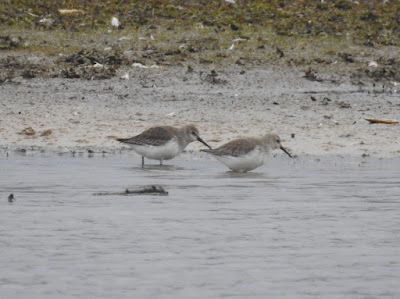The long forecast cold easterly air, straight from Siberia, as ever nicknamed 'the beast from the east', began to take hold last week. By mid week, there were signs of cold weather movements of birds, mainly Lapwings and Fieldfares from my own observations. Small flocks could be seen moving west and south west ahead of the ever decreasing air temperatures. By the 28th, probably the coldest day of the week with temperatures here peaking at -3 degrees, there had been a small displacement of waders locally within the county. There were reports of Dunlin, Ruff and even Knot from various sites. On the 1st, I decided to take a quick look at the lake to see whether there had been any new arrivals. I didn't stay too long because temperatures were below freezing and there was an uncomfortably strong easterly blowing, part of storm Emma. In fact, the lake was about as empty of birds as I had ever seen it. Only a small part of the north western arm was frozen, as the strong winds seemed to be keeping ice at bay on the main lake, but almost all of the ducks seemed to have departed and the spit looked devoid of birds. I eventually found a lone Dunlin making its way around the spit edge near the main island, but left shortly after.On the 2nd, Jim R made a visit in similarly horrible conditions and discovered a godwit, which he identified as a Bar-tailed, though it seemed to depart shortly after being found. There were also now two Dunlin.
Simon R was down early on the 3rd. The previous couple of days' snow was thawing quickly and temperatures had positively rocketed to high single figures! He found a godwit again and assumed that it must be the previous day's bird. By the time Graham S had joined him, despite being distant, they were sure it was Bar-tailed. Mike M was present also and found a cracking male Goosander out on the east side of the lake. I arrived around 10:30, quickly saw the Goosander and then made my way to the south bank to look for the Barwit, which was right at then base of the east side of the spit. As I reached Simon and Graham, they told me that the godwit had just walked into some adjacent vegetation and was out of view. I have no idea what this bird was doing, but an hour and a half later, when I had to leave, the bird had still not reappeared. This was gutting, as Barwit is a rare patch bird - I have only had two previous records, both in 2011 when there was a large overland passage of this species. Typically, later in the afternoon the Barwit reappeared on the spit. I had to wait until 5pm to make a return visit and finally saw it reasonably close on the west side of the spit, but roosting. Still, a great birds to see and all thanks to the weather. There were also now three Dunlin present. Not too far away at Dorney Lake, Dave C had found 16 Dunlin, Sanderling, Ruff and Redshank, so more displaced waders.
 |
| A good record, scarce and usually short stayers |
Just before 9am, I noticed an adult winter Little Gull descend to the near spit and land on the water just behind it. Could this be the same bird that I had seen over an hour ago, or was I looking at a second? I'll probably never know, as both were non-breeding adults, but whether one or two birds I didn't care as I could now spend time watching this little beauty at close range. It decided to come out of the water and spent a few minutes standing on the spit with the Black-headed Gulls before taking flight, making the same call I had heard earlier and then flew off west over the STW.
I made my usual circuit on the morning of the 6th, the Barwit had gone, being last seen on the 5th, a stay of four days and the previous day's four Dunlin had dropped to two. I counted the Shoveler and reached 68 birds, a reasonable total. They always seem to build in number as Spring approaches before departing en masse. Strangely, all the Wigeon left the site a couple of weeks ago - really odd and I'm not really sure why, but there were four Shelduck.
As I approached the northern fields, I noticed some Meadow Pipits on the wires. They soon took flight and I counted 13 birds as they flew over the middle hedge to the field the other side. This area often produces flocks of Mipits in the Spring as they migrate through and I have seen up to 80 birds together in the past. I passed the hedge and began to watch the Mipits feeding in the field. A few took flight to the top of the adjacent hedge and as I followed them, I suddenly noticed a Stonechat perched up a little bit farther up the hedge. I am pretty sure that I would have missed this if not for the Mipits, so was well pleased. I have only ever seen one previous Stonechat here in Spring, with most of my records being Autumn migrants.
 |
| Distant crops - bird was 80-100 yards away |
With the onset of Spring upon us, I cant wait to see the returning summer birds in a few weeks, when patch birding should really take off.










No comments:
Post a Comment